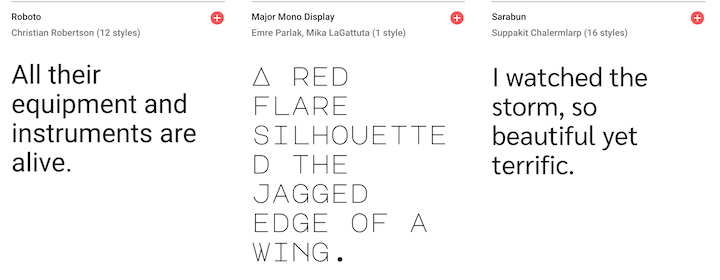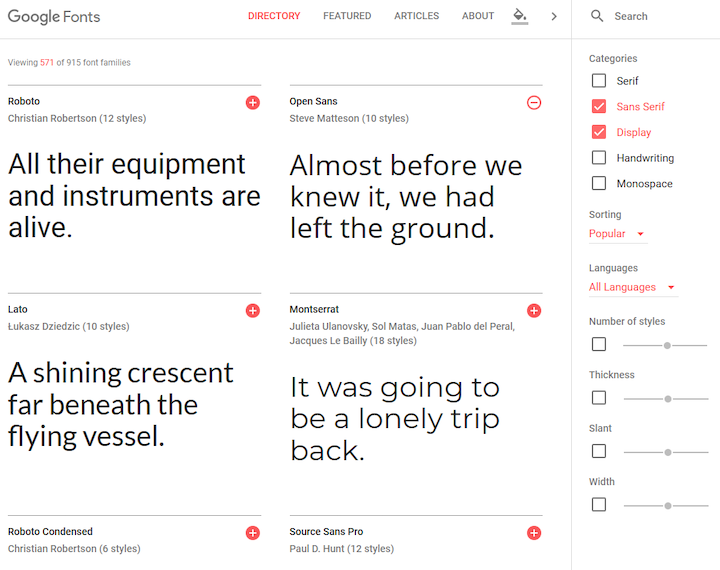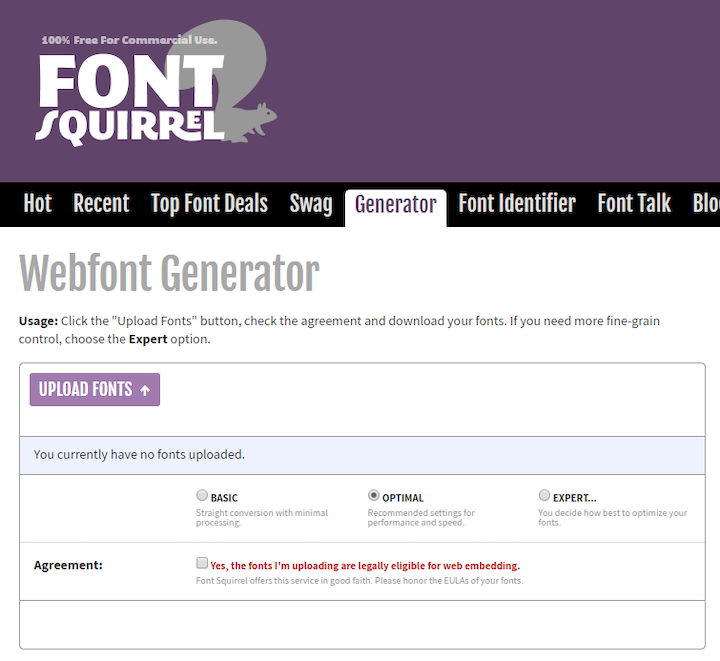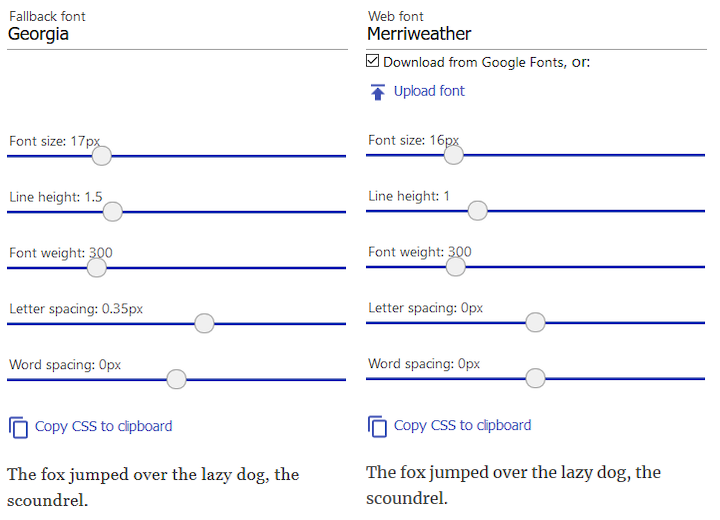Describe the Five Generic Typeface or Font Families and When to Use Each
Editor'south notation: This spider web fonts in CSS tutorial was last updated on 30 June 2021 to remove outdated information about browser back up for variable fonts. It may still contain information that is out of date.
In the early days, designers were limited to popular arrangement fonts such as Arial, Helvetica, Verdana, and Times New Roman. Reliable custom font use was merely possible with image replacement or plugins such every bit Flash.
Basic support for web fonts was introduced in Internet Explorer iv.0 released in 1997. However, it took more than a decade for cantankerous-browser technology to be implemented by the @font-face tag. The availability of new open-source fonts as well prevented legal bug from vendors who were reluctant to allow unrestricted employ of commercial typefaces.
In this tutorial, we discuss diverse techniques and best practices for adding custom fonts to webpages. We'll encompass the following:
- Do y'all really need web fonts?
- What web fonts tin can you use in CSS?
- How to use web fonts in CSS
- How to use spider web fonts from a font repository
- Example: How to add the Open up Sans font in CSS
- How to use your own spider web font files in CSS
- FOUT and FOIT
- Treatment font weights and styles in CSS
- Variable fonts

Do you really need web fonts?
Merely because yous can add dozens of fonts to every page doesn't mean you lot should. Hither's why:
- Designers recommend using fonts sparingly, with just 1 or ii typefaces per document
- Custom fonts typically require a few hundred KB. The more than you lot add, the larger your folio weight, and the worse your page performance. This tin can be especially problematic on mobile devices and slower networks
- The days of every site using standard OS fonts such as Helvetica or Times New Roman have long gone — there are fewer reasons not to use them

What web fonts can yous use in CSS?
Operating system fonts come up for gratuitous and can provide a noticeable functioning boost. Each platform differs in the fonts it offers, just fallbacks tin be specified also as the generic font family names of serif, sans-serif, monospace, cursive, fantasy, organisation-ui, etc.
body { font-family: Arial, Helvetica, sans-serif; } Web apps may also feel more native if they utilise a standard system font. For example, the following stack implemented at GitHub targets organisation fonts available across MacOS, iOS, Windows, Linux, and Android platforms:
body { font-family: -apple-arrangement, BlinkMacSystemFont, "Segoe UI", Roboto, Helvetica, Arial, sans-serif, "Apple tree Colour Emoji", "Segoe UI Emoji", "Segoe UI Symbol"; } Medium and the WordPress administration panels utilise a similar version:
body { font-family: -apple-system,BlinkMacSystemFont,"Segoe UI",Roboto,Oxygen-Sans,Ubuntu,Cantarell,"Helvetica Neue",sans-serif; } Web-safe fonts that you tin can use with CSS include:
- Arial (sans-serif)
- Verdana (sans-serif)
- Helvetica (sans-serif)
- Tahoma (sans-serif)
- Trebuchet MS (sans-serif)
- Times New Roman (serif)
- Georgia (serif)
- Garamond (serif)
- Courier New (monospace)
- Brush Script MT (cursive)
For more information about fonts that are compatible with CSS and HTML, bank check out this list of CSS web-rubber fonts.
How to use web fonts in CSS
If a stack requires several declarations in a stylesheet, it may exist practical to use a CSS preprocessor such as Sass:
$font-stack: "Segoe UI",Roboto,Ubuntu,sans-serif; body { font-family: $font-stack; } CSS custom properties:
:root { font-stack: "Segoe UI",Roboto,Ubuntu,sans-serif; } trunk { font-family: var( — font-stack); } Yous can also use a @font-face declaration that references local fonts:
@font-face { font-family unit: fontstack; font-mode: normal; font-weight: 300; src: local("Segoe UI"),local("Roboto"),local("Ubuntu"); } torso { font-family: fontstack, sans-serif; } How to use web fonts in CSS from a font repository
If a system typeface makes your marketing managing director wince, there are several repositories that offer a broad range of open-source fonts that are served from a content commitment network (CDN). Popular options include:
- Google Fonts
- Font Library
- Adobe Edge
Google Fonts is the most popular font repository. Information technology provides a searchable list, weight and manner customization options, and load fourth dimension interpretation.

Instance: How to add the Open Sans font in CSS
To embed a font in a page, use the standard <link> tag in the HTML head:
<link href="https://fonts.googleapis.com/css?family=Open+Sans" rel="stylesheet">
The font will be downloaded and candy in parallel with your own stylesheet.
Alternatively, you can utilize a CSS @import:
@import url('https://fonts.googleapis.com/css?family unit=Open up+Sans'); The downside is that this blocks the processing of further stylesheets until the font styles have been parsed.
The web font can then be set in whatever CSS declaration. Here's how to include the Open Sans font in CSS:
body { font-family: "Open up Sans", sans-serif; } You tin can further optimize the URL API — for instance, past requesting multiple families:
https://fonts.googleapis.com/css?family=Inconsolata|Droid+Sans
…with differing weights and styles:
https://fonts.googleapis.com/css?family unit=Inconsolata:500,700 https://fonts.googleapis.com/css?family=Roboto:bolditalic
Or past limiting the font to known letters — perchance for a logo or heading:
https://fonts.googleapis.com/css?family unit=Inconsolata&text=hullo
Refer to "Get Started with the Google Fonts API" for more information.
How to apply your own web font files in CSS
Any font file can be used in your webpage but make sure y'all check that you take permission from the possessor of the typeface. All modernistic browsers support WOFF format. WOFF2 offers typical compression savings of thirty percent merely is not supported by Internet Explorer. For older or more obscure applications, TTF, EOT, or SVG may exist an option.
The Font Squirrel Webfont Generator provides a simple tool to upload one or more fonts, tweak settings, and download a kit containing the converted fonts and CSS lawmaking.

By default the Webfont Generator provides a WOFF2 font, a WOFF fallback, and the appropriate CSS @font-face settings. For example:
@font-face { font-family unit: 'mytypeface'; src: url('mytypeface-webfont.woff2') format('woff2'), url('mytypeface-webfont.woff') format('woff'); font-weight: normal; font-style: normal; } trunk { font-family: mytypeface, serif; } FOUT and FOIT
A web font may take several seconds to download, especially on a slower device or network. The browser can choose to:
- Bear witness a Wink of Unstyled Text (FOUT). The first available fallback is used immediately, then replaced by the web font once information technology has loaded. This process is used by IE, Border eighteen and beneath, and older editions of Firefox and Opera
- Prove a Flash of Invisible Text (FOIT). No text is shown until the spider web font has loaded. This process is used in all modernistic browsers, which typically wait three seconds before reverting to a fallback
It is possible to control some aspects of the browser'due south font rendering process.
Set a font flash favorite with font-display
The font-brandish property allows you to define which process is used in Firefox, Safari, and Chromium-based browsers. The options include:
-
auto, the browser'south default behaviour. This is the easiest option but may not provide the best reading experience -
block, which is finer FOIT — the text may be invisible for up to iii seconds. There is no font bandy, but it can make a site feel slower because text is not immediately available -
swap, which is effectively FOUT — the first fallback is used until the web font is available. Text tin can be read without any delay, but the font swap effect can be jarring if non managed finer -
fallback, a compromise between FOIT and FOUT — text is invisible for a curt period (typically 100ms) so the commencement fallback is used until the spider web font is available. Although text is readable as the page load, the font swap could still be problematic -
optional, which is the same equally fallback, except that no font swapping will occur. The web font volition only exist used if it is bachelor within the initial menses. The start folio view is probable to testify a fallback font while the spider web font is downloaded and buried. Subsequent page views volition use the web font. This could exist a reasonable option if the web font and fallback are similar but, in that case, is a web font really necessary?
Here's an example:
@font-face { font-family: 'mytypeface'; src: url('mytypeface-webfont.woff2') format('woff2'), url('mytypeface-webfont.woff') format('woff'); font-weight: normal; font-style: normal; font-display: bandy; } Different fonts could use different settings. For example, body text could apply swap (FOUT) then information technology tin can exist read immediately while menus and heading text use cake (FOIT).
Enforcing FOUT with JavaScript
The font-display holding is probable to be undefined or auto when using typefaces from repositories such as Google Fonts (although changes to the API are being considered). In nearly browsers, text volition be invisible for several seconds (FOIT).
In that location are several libraries available to help you lot implement FOUT-similar loading, such as the Typekit webfontloader, which uses JavaScript to command how fonts are loaded. Nigh follow the same process, which can be replicated with a few lines of lawmaking.
Get-go, a system fallback is defined as the primary font in CSS:
torso { font-family unit: Georgia, serif; } JavaScript is and so used to fetch the web font and append a new class (such as wt-active) to the HTML <trunk> tag once it has downloaded:
(() => { // load Google font let font = document.createElement('link'); font.rel = 'stylesheet'; font.href = 'https://fonts.googleapis.com/css?family=Merriweather'; font.onload = () => document.body.classList.add('wf-active'); document.head.appendChild(font); })(); A farther CSS declaration then overrides the default fallback font with the web font when the wt-agile course appears:
body.wf-active { font-family: Merriweather; } Effective FOUT reflow
A flash of unstyled text can be jarring when the fallback and spider web fonts are significantly dissimilar and crusade a noticeable layout reflow. A tool such as Font manner matcher can assistance minimize the consequence past setting appropriate weights, line heights and spacing for the fallback and/or web font.

The resulting replacement causes fewer issues when reading body text regardless of how long it takes to load the font:
Handling font weights and styles in CSS
Each font file has its own weight (disrespect), style (italic slant), stretch, and variants. The browser will attempt its own interpolations if you make adjustments to the CSS without loading an associated font. Rendering will be slower, fonts may wait worse, readability could be afflicted, and widths could be dramatically different and break layouts. For example:
/* load font with a weight of 300 */ @import url('https://fonts.googleapis.com/css?family=Open+Sans:300') body { font-family: "Open Sans", serif; } /* simply utilize a weight of 600 - do non do this! */ strong { font-weight: 600; } The solution is to load a split up font file for every weight and fashion you require then explicitly set all styles appropriately:
/* load font with weights of 300 and 600 */ @import url('https://fonts.googleapis.com/css?family=Open+Sans:300,600'); /* weight 300 for all elements */ * { font-weight: 300; } body { font-family: "Open Sans", serif; } /* weight 600 for assuming elements */ h1, h2, h3, strong { font-weight: 600; } Variable fonts
Loading divide font files for every variation of weight and style is rapidly becoming unnecessary thanks to variable fonts.
OpenType 1.8 introduced variable fonts in 2016. Rather than creating multiple files for each variation of the aforementioned typeface, variable fonts ascertain minimum and maximum vector limits forth an axis:

Any font-weight betwixt these two extremes can now be interpolated. Depending on the font, you may be able to adjust aspects of the typeface.
Weight
The thickness of the font tin can be set between one and 1000 using the following:
font-weight: 400; /* or */ font-variation-settings: 'wght' 400;
Width
The font can be stretched to produce condensed or extended variations. 100% is normally considered the default with ranges above or below that value for narrower or wider widths accordingly:
font-stretch: eighty%; /* or */ font-variation-settings: 'wdth' 80;
Italic
The italic axis is either on or off considering standard and italic characters can be different:
font-style: italic; /* or */ font-variation-settings: 'ital' 1;
Slant
The slant — or oblique — differs from italic in that the letterforms are not changed simply can vary on an axis typically betwixt 0 and 20 degrees:
font-mode: oblique 10deg; /* or */ font-variation-settings: 'slnt' 10;
Resource files can be discovered at sites including five-fonts, Axis-Praxis, and Font Playground.
Variable font files can be loaded using @font-confront with a woff2-variations format and the allowable ranges. For instance:
@font-face { font-family: 'MyVariableFont'; src: 'myvariablefont.woff2' format('woff2-variations'); font-weight: 200 800; font-stretch: 75% 125%; font-style: oblique 0deg 20deg; } Specific styles can then be fix in any selector with multiple CSS backdrop:
p { font-family: 'MyVariableFont'; font-weight: 300; font-stretch: 100%; font-fashion: oblique 0deg; } You can as well employ the shorthand font-variation-settings holding:
p { font-family: 'MyVariableFont'; font-variation-settings: 'wght' 300, 'wdth' 100, 'slnt' 0; } Variable font support can be tested with a CSS @supports query:
p { font-family unit: FallbackFont; } @supports (font-variation-settings: 'wght' 300) { p { font-family: 'MyVariableFont'; font-variation-settings: 'wght' 300, 'wdth' 100, 'slnt' 0; } } This makes it possible to load standard single-style font files for older browsers and add further styles when variable fonts are supported. Unfortunately, most browsers will download all fonts, which negates whatsoever operation benefit from a single variable font file.
Conclusion
Web fonts accept revolutionized site typography during the by decade. Designers take fewer constraints and tin implement typefaces that piece of work on all mainstream devices and browsers.
However, font download weight, site performance, and managing the flash of unstyled or invisible text remain issues. A standard OS font should always exist your starting time consideration.
Variable fonts are the futurity. These offer multiple variations, the potential for new typeface-based effects, cutting page weight, and simplify development. They are an exciting development and browser support for variable fonts has become more than widespread over the years.
Is your frontend hogging your users' CPU?
Every bit web frontends get increasingly complex, resource-greedy features need more and more from the browser. If y'all're interested in monitoring and tracking customer-side CPU usage, retentiveness usage, and more for all of your users in production, attempt LogRocket. https://logrocket.com/signup/
https://logrocket.com/signup/
LogRocket is like a DVR for web and mobile apps, recording everything that happens in your web app or site. Instead of guessing why problems happen, you can amass and report on key frontend performance metrics, replay user sessions along with application state, log network requests, and automatically surface all errors.
Modernize how you debug web apps — Start monitoring for gratis.
Source: https://blog.logrocket.com/web-fonts-in-css-how-to-examples/

0 Response to "Describe the Five Generic Typeface or Font Families and When to Use Each"
Post a Comment